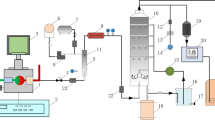Abstract
SO x and NO x have both previously been identified as primary precursors of acid rain, and thus the abatement of SO x and NO x emissions constitutes a major target in the field of air pollution control. In this study, the efficacy of a pilot-scale scrubber was evaluated with regard to the simultaneous removal of SO2, NO and particulate with wet catalysts. The removal efficiencies of particulate were measured to be 83, 92 and 97% with catalyst flux of 0.5, 0.8 and 1.5 L/min, respectively. The average removal efficiencies of particulate with different nozzles were approximately 94 and 90% with FF6.5 (5/8 in.) and 14 W (1.0 in.) nozzles, respectively. At least 96–98% of particulate and SO2 were removed, regardless of the stage number of reactor. In a one-stage scrubber, 83.3% removal efficiency of NO was achieved after 48 hours; however, the two-stage scrubber achieved an NO removal efficiency of 95.7%. Regardless of the liquid-gas ratio, SO2 and particulate were removed effectively, whereas NO was removed about 84% and 74% under liquid-gas ratio conditions of 39.32 L/m3 and 27.52 L/m3, respectively. In experiments using STS and P.P. pall ring as packing material, particulate and SO2 removal efficiency values in excess of 98% were achieved; however, NO removal was correlated with the different packing materials tested in this study. With the above optimum operation conditions, even after 20 hours, the removal efficiency for NO stayed at 95% or higher, the removal efficiency for SO2 stayed at 97% or higher, and the removal efficiency for particulate stayed at 92% or higher. In accordance, then, with the above results, it appears that this process might be utilized in scrubber systems, as well as systems designed to simultaneously remove particulate, SO2 and NO from flue gas.
Similar content being viewed by others
References
T. W. Chien and H. Chu, Journal of Hazardous Materials, 80, 43 (2000).
H. K. Lee, B. R. Deshwal and K. S. Yoo, Korean J. Chem. Eng., 22, 208 (2005).
M. Kang, J. H. Park, J. S. Choi, E. D. Park and J. E. Yie, Korean J. Chem. Eng., 24, 191 (2007).
J. H. Choi, J. H. Kim, Y. C. Bak, R. Amal and J. Scott, Korean J. Chem. Eng., 22, 844 (2005).
C. D. Cooper and F. C. Alley, Air pollution control: A design approach, 2nd Ed., Waveland Press Inc., Illinois, USA (1994).
G. T. Jeong, G. Y. Lee, D. H. Park and J. M. Cha, Applied Biochemistry and Biotechnology, 129–132, 1077 (2006).
W. H. Yang and M. H. Kim, Korean J. Chem. Eng., 23, 908 (2006).
I. G. Jung, O. H. Park, H. J. Woo and C. H. Park, Biotechnol. Bioprocess Eng., 10, 34 (2005).
C. L. Yang, H. Shaw and H. D. Perlmutter, Chem. Eng. Comm., 143, 23 (1996).
E. Sada, H. Kumazawa, I. Kudo and T. Kondo, Ind. Eng. Chem. Process Des. Dev., 20, 46 (1981).
J. L. De Pavia and G. C. Kachan, Ind. Eng. Chem. Res., 37, 609 (1998).
H. Chu, T. W. Chien and S. Y. Li, Science of the Total Environment, 275, 127 (2001).
H. Perlmutter, H. Ao and H. Shaw, Environ. Sci. Technol., 27, 128 (1993).
Y. Shi, H. Wang and S. G. Chang, Environ. Prog., 16, 301 (1997).
Y. S. Ko, Simultaneous removal characteristics of NO x, SO 2 from combustion gases using plasma chemical reaction, MS thesis, Kyungnam University (2000).
S. G. Jin, J. M. Cha, I. W. Lee, S. J. Yoon and S. W. Kim, Journal of The Korean Industrial and Engineering Chemistry, 7, 177 (1996).
S. H. Jung, Simultaneous removal of SO 2 /NO using aqueous-catalyst in scrubber, Ph.D. Dissertation, Chonnam National University (2007).
Y. Hishinuma, R. Kaji, H. Akimoto, F. Nakajima, T. Mori, T. Kamo, Y. Arikawa and S. Nozawa, Bull. Chem. Soc. Jpn., 52, 2863 (1979).
P. Harriott, K. Smith and L. B. Benson, Environmental progress, 12, 110 (1993).
H. W. Hsu, C. J. Lee and K. S. Chou, Chem. Eng. Commun., 170, 67 (1998).
Author information
Authors and Affiliations
Corresponding author
Rights and permissions
About this article
Cite this article
Jung, SH., Jeong, GT., Lee, GY. et al. Simultaneous removal of SO2, NO and particulate by pilot-scale scrubber system. Korean J. Chem. Eng. 24, 1064–1069 (2007). https://doi.org/10.1007/s11814-007-0122-7
Received:
Accepted:
Published:
Issue Date:
DOI: https://doi.org/10.1007/s11814-007-0122-7




